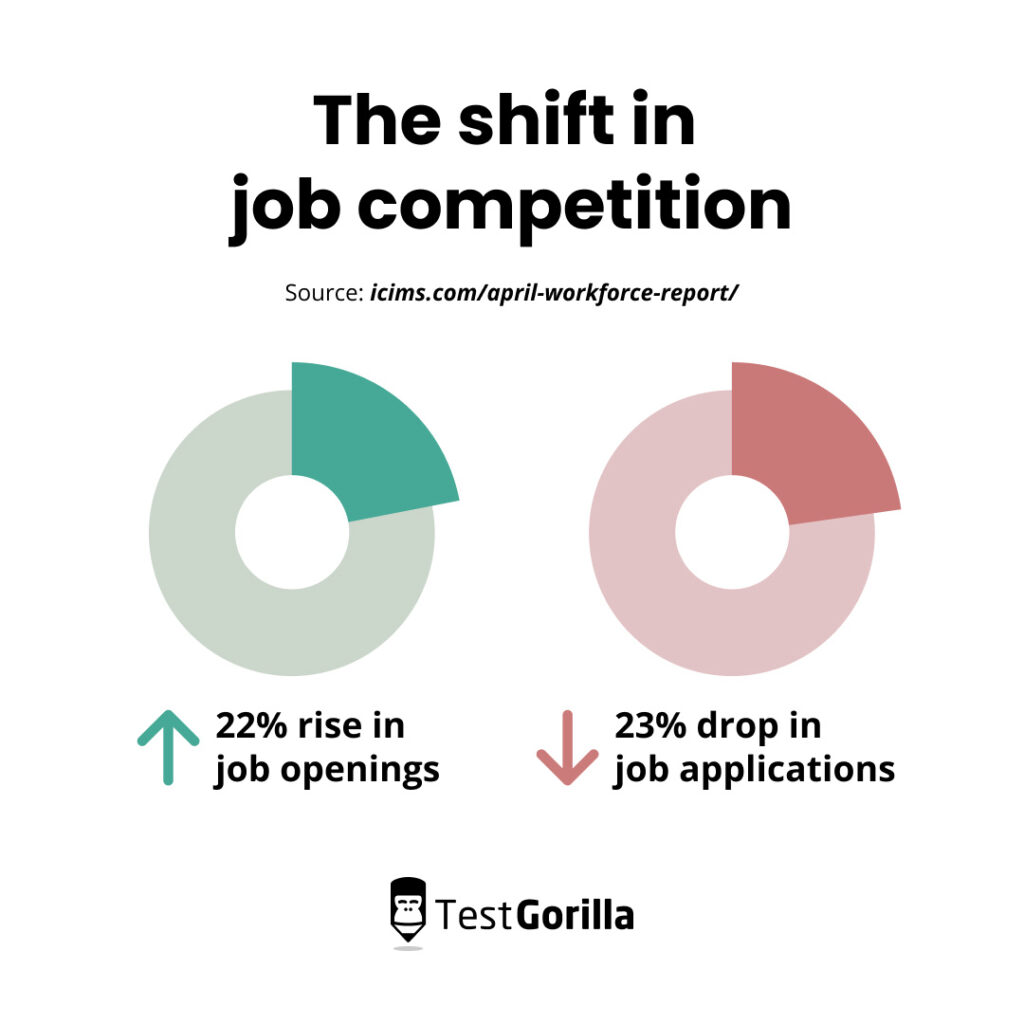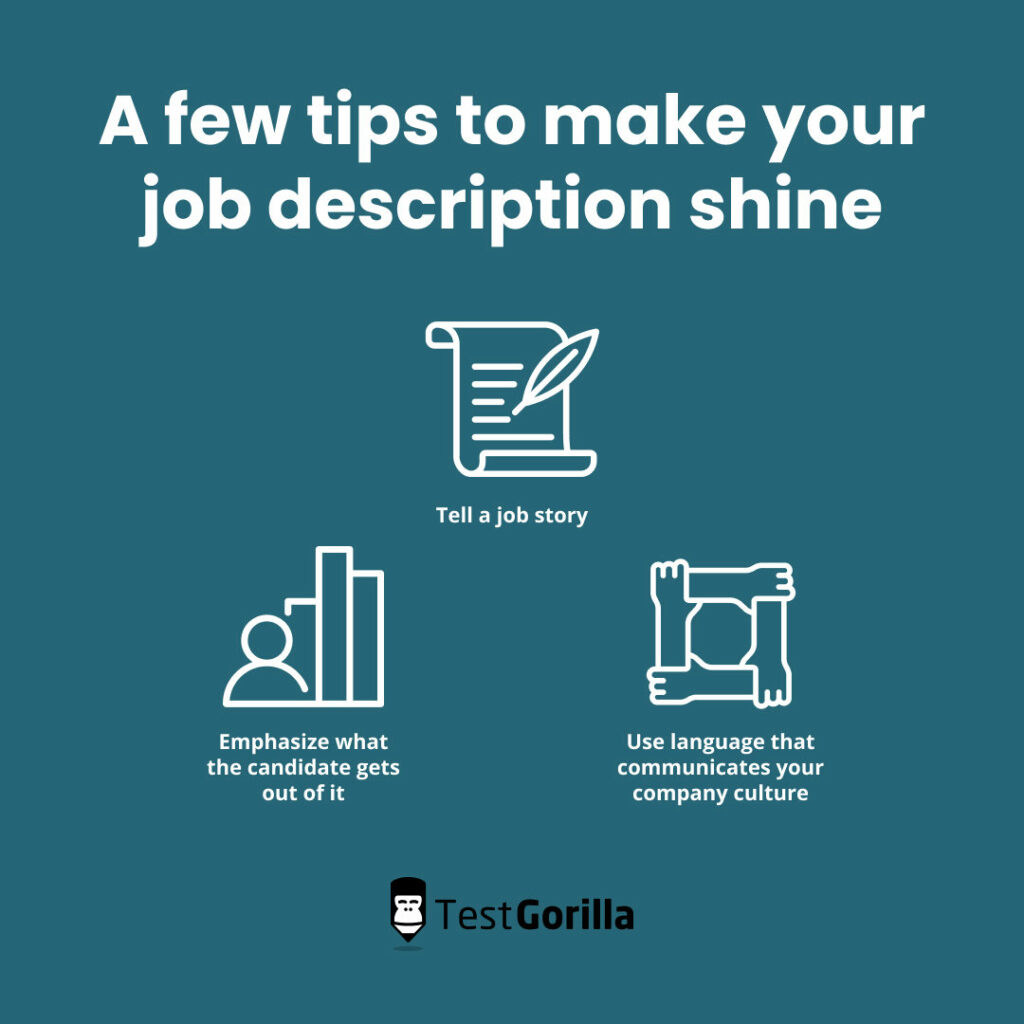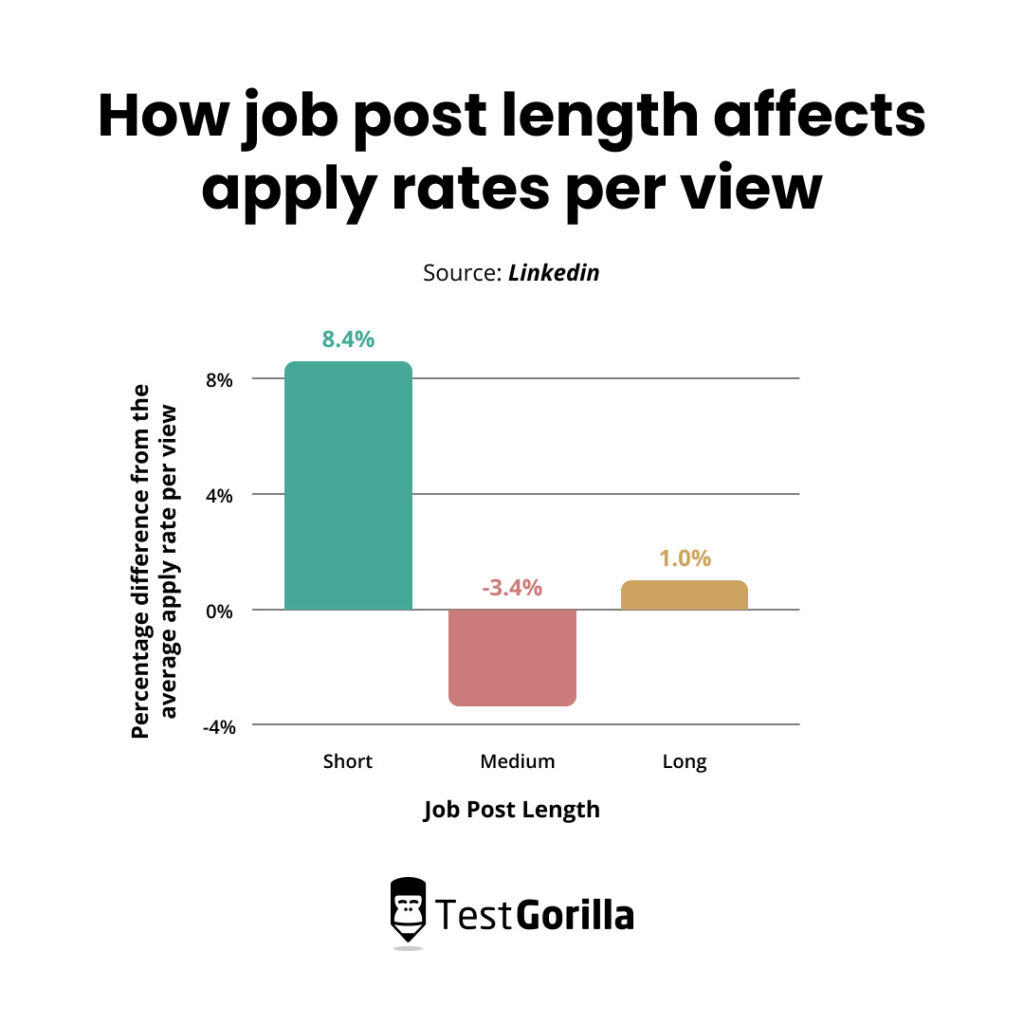More job openings and fewer job applicants – it’s definitely a difficult world for a recruiter right now.
According to the April Workforce Report[1], job openings have risen 22% since the start of the year, but job applications have dropped by 23%.
If you want to close that gap and get more applicants for a job you’re posting, you need to shake up your hiring process.
This competition for the best talent means you need to make your positions more attractive and your job descriptions more enticing. It’s an opportunity for you to display your company as an amazing, top-tier place to work that focuses on reducing bias and hiring for skills.
Learning how to increase the number of job applicants doesn’t have to be trial and error. We’ve got some tested tips to help you get started.
This article details the top 12 best strategies for updating and polishing your hiring process, including dropping reliance on resumes, turning to skills-based hiring, and offering job flexibility.
12 tips for attracting more job applicants
Let’s jump right into the best ways to get more applicants for a job so you can start attracting more of the ideal candidates for your open positions.
Summary of our best practices
Strategy | Description |
1. Turn to skills-based hiring to widen your talent pool and attract more diverse talent | Hire candidates for their skills and capabilities to get the best applicants |
2. Rely on screening assessments rather than resumes | Get more diverse applicants by reducing reliance on resumes |
3. Make your application process quick and effortless | Cut the time needed to apply and make it mobile-friendly |
4. Provide job flexibility and let candidates know about it | Offer alternative working arrangements like remote and hybrid work |
5. Make sure your job descriptions stand out from the crowd | Include videos and stories and ditch exclusive terms |
6. Include a salary range and the key benefits | Offer salary transparency, clear benefits, and a competitive wage |
7. Keep descriptions brief and to the point with zero fluff | Write short job descriptions that give candidates details without fluff |
8. Shout your company values from the rooftops | Make your company values well-known so applicants know your culture and beliefs |
9. Build your employer brand and manage your online reputation | Manage and promote your online reputation and make sure it’s consistent |
10. Publish job applications on multiple channels | Use multiple channels when posting your job ad to get the attention of as many applicants as possible |
11. Open up to hiring freelancers and contractors | Give project-based hiring a try and fill roles with contingent workers |
12. Reach out to relevant candidates in your talent pool and encourage them to apply | Take a proactive approach and simply ask the best candidates to take a look at your career offers |
1. Turn to skills-based hiring to widen your talent pool and attract more diverse talent
You can attract more diverse applicants when you hire for skills and capabilities and not unnecessary requirements.
Skills-based hiring helps you say goodbye to work experience and educational requirements where they’re not strictly needed.
Over-reliance on college education, like four-year degrees, not only narrows your talent pool but is also a major DEI (Diversity, Equity, and Inclusion) issue.
A 2019 study shows the disproportion of the attainment of a bachelor’s degree by ethnicity and race in the US.
In each group, here’s the percentage of students who attained a bachelor’s or higher degree:
25% of Hispanic students
28% of Black students
45% of White students
72% of Asian students
This means that a four-year degree requirement is automatically doubling the number of White candidates and reducing the amount of potential Black or Hispanic candidates to only a third of the available applicants.
The same principle applies to attaching work experience to a role where it isn’t strictly needed. Not every great candidate has years of professional experience, and you could be missing out on real talent because of it.
A sales professional might have zero years of professional programming experience, but a decade of personal experience from doing it as a hobby and helping friends.
Or consider an influencer who doesn’t have any documented marketing experience, but has a wealth of knowledge about attracting and maintaining an audience.
We’d recommend reducing reliance on both minimum and maximum amount of work experience. Capping the amount of experience you accept and deeming a candidate “overqualified” can lead to age discrimination.
However, skills-based hiring doesn’t mean you have to get rid of the necessary requirements, such as medical degrees or driving licenses.
For example, TestGorilla enables recruiters to use qualifying questions to ensure a candidate meets the necessary criteria before moving on to the actual application.
2. Rely on screening assessments rather than resumes
De-emphasizing your reliance on resumes encourages more stellar applicants to join your talent pool.
Many candidates self-select out of the hiring process because they don’t have a “strong enough” resume.
When you rely too heavily on resumes, and cover letters, you pass over excellent talent who simply have a non-conventional background.
That could have happened to our own Sheena Muirden, TestGorilla’s Content Marketing Coordinator, because she has a background in hospitality roles like bartender and waitress. Luckily, TestGorilla’s hiring process doesn’t put too much weight on the “right” resume.
It isn’t just our opinion either. It’s what data says about resume screening effectiveness.
In our global survey on the efficacy of resumes, quite a few complaints from hiring managers turned up:
“I couldn’t tell from the resumes if the applicant had the right skills.”
“I wasn’t sure if the resume was accurate.”
“I didn’t recognize the names of the companies the candidate had worked for.”
So why do we still rely on them? Perhaps because of another response from the survey:
“I have no way to rank applicants except for years of experience.”
That can change.
Try switching to a system that ranks candidates on their capability to get the job done, like pre-employment skills testing.
Here are a couple of examples that list a job role and a handful of assessments to go with them:
Job role | Applicable skill tests |
HR coordinator | |
Sales representative |
Skills tests enable candidates to use their valuable transferable skills to move into a role without the perfect work history and resume.
This gives hiring managers a surefire way to rank applicants and find the right candidate without wading through a sea of resumes to ultimately come up empty-handed.
To find out more about how skills tests facilitate the hiring process and enable recruiters to drop unreliable requirements, read our 10 stories that demonstrate the power of skills-based hiring.
3. Make your application process quick and effortless
The modern candidate wants a job application process that’s easy, fast, and accessible.
Lengthy, complicated applications are narrowing your talent pool and decreasing your applicants. A majority of candidates abandon job applications midway due to the length and complexity[2].
That’s why it’s important to make sure your application process is:
Quick to finish
Easy to fill out
Mobile-responsive
A study by Glassdoor showed that 58% of job seekers are looking for jobs on their phones. The same study showed that reducing the time needed to complete an application increases the number of job applications from both mobile and desktop users.
Candidates are busy, and with the majority of them searching for employment via a smartphone, it shows that they aren’t willing to settle for a lengthy process anymore.
Ensure your application process is succinct and contains only the necessary requirements. Here are a few things that may be irrelevant for most job applications:
Personal information: Asking for an applicant’s date of graduation or date of birth is irrelevant. It can also open the door to ageism and, for some personal information, it’s illegal.
Social security number: This information isn’t necessary until you’re ready to move to the final stages of hiring; until then, it just carries an unnecessary risk for privacy and identity theft.
Criminal history: Even if your area doesn’t have specific “ban the box” laws, asking for a candidate’s criminal history in the application doesn’t align with fair chance hiring practices.
One last thing – let your candidates know right in the description (“Apply in just 5 minutes!”), so they know right off the bat that your application is quick and easy.
4. Provide job flexibility and let candidates know about it
Job autonomy is a priority for candidates in the post-pandemic world, and that includes location and time flexibility.
It’s a huge benefit to your hiring process when you let your candidates know upfront that you offer alternative working arrangements like:
Remote work
Hybrid office models
Compressed work week (like a 9/80 work schedule)
Hung Lee, a recruiter at Brainfood, talks about how offering remote work in applications doubles the applicant volume. He goes on to say that the potential for remote work increased women applicants by 120%.
Everyone wants more work autonomy nowadays. For some people, it’s not just a desire; it’s a necessity. Working parents, students, and people with alternative lifestyles need the option to fit their work schedule around childcare, college classes, and more.
We’d recommend going remote or hybrid with every job role where it makes sense for your business. Easing up on geographic restrictions opens you up to far more applicants.
A flexible working policy gives workers a chance at an ideal work-life balance and enables them to work when they’re most productive. It’s no wonder so many job seekers look for that option in the job description.
5. Make sure your job descriptions stand out from the crowd
Our data from the intro of this blog shows that job openings far outnumber job applicants, so it’s easy for job descriptions to get lost in the crowd.
This tells us that if your job ad is just more of the same, candidates will toss it aside with the 500 other cookie-cutter descriptions.
So how do you make your job listing catch the candidate’s eye?
Here are a few tips to make your job description shine:
Tell a job story: Spin a story about an average day in the job role, maybe including a short video about the company and the team. Job ads with video content can increase applications by 36%.
Emphasize what the candidate gets out of it: It’s natural for the candidate to want to know what’s in it for them. So, tell them! Describe benefits, incentives, and possible career growth (more on that later).
Use language that communicates your company culture: Culture is a top job satisfaction factor, and relaying that to candidates within the job description tells them whether or not they’re a good culture add.
If you want some tips on how to use language that connects to your organizational culture, check out our blog on how to describe your company culture.
While we’re talking about language, we have to mention writing inclusive job descriptions without unconscious bias or “loaded terms.”
Your terminology could be unintentionally turning candidates away, reducing your workplace diversity at the same time.
For example, words like “energetic” and “digital native” tend to put off older workers and can lead to age discrimination in hiring.
Other words like “rockstar” and “ninja” have been shown to decrease the number of women applicants[3]. They seem like such innocent, neutral terms, but they’re unintentionally increasing the gender employment gap.
To learn more about these terms, check out our entire DE&I glossary.
6. Include a salary range and the key benefits
Right next to work autonomy, salary transparency is a top priority for today’s candidates.
When it’s a job seeker’s market, candidates need to know that the position is what they’re looking for, is worth their time, and checks all their boxes.
There’s nothing wrong with a candidate being interested in a position for the salary. When you’re transparent and honest, you’re displaying your company values along with attracting these candidates.
This is especially important when hiring Gen Z.
The State of Gen Z 2021-2022 showed that the highest driver for Gen Z applicants is salary transparency, along with future salary ranges and salary growth.
All of this goes for benefits, too. Clearly lay out the benefits and incentives employees at your organization get, such as health and wellness perks.
It might also be in your best interest to consider a healthy signing bonus.
Many companies are offering lucrative signing bonuses due to the Great Resignation. For instance, Walgreens recently announced that they’re offering pharmacists a $75,000 signing bonus.
This is much higher than their usual $30,000 to $50,000 signing bonus.
Walgreens made a public statement saying this is only one of many steps they’re taking to address the pharmacy staffing issue they’re facing.
Job seekers aren’t looking for a job for fun – candidates want and need to be paid fairly, so make your salary and benefits attractive. You won’t get top talent by paying below-average wages.
7. Keep descriptions brief and to the point with zero fluff
If candidates want to apply for a job quickly, you can bet they also want a quick description.
Job seekers are much more likely to navigate away from the page if the description looks more like a thesis than a job ad.
Job descriptions under 300 words do much better than longer ones.
Short job descriptions attract more applicants and put off fewer people with an impossible list of “requirements.”
Plus, listing a necessary proficiency level doesn’t do as much as you think. People have different ideas of “intermediate” and “expert.”
Your online skills assessments are a better place to check for the necessary skill set than the job description. Instead of listing arbitrary requirements like “the ability to process XYZ amount of data in 10 minutes,” test them directly with a Working with Data test and a Time Management test.
Incredibly detailed job descriptions always have a chance to attract unqualified candidates, but what’s worse is that they can put off qualified candidates.
If an applicant thinks that they can’t process that much data (even though they can), they won’t even bother applying.
8. Shout your company values from the rooftops
More and more candidates are searching for a company with clear values, strong beliefs, and solid organizational culture.
People will want to work for you if they feel like they can live their personal values in your organization and make a real difference when employed.
A great example is from Virgin Atlantic, a UK airline company, which had job applications increase by 100% after scrapping its gender-based dress code.
This loudly proclaimed to all potential candidates that Virgin Atlantic is forward-thinking, gender-inclusive, and LGBTQIA-positive.
Everyone would love to work for a company that shares their beliefs and vision, but some candidates insist on it. One study showed that 49% of Gen Z would not accept a job offer from a company whose values do not align with their own.
Candidates want a company they can be proud to be a part of – one that they know is aligned with everything they stand for. So wear your heart on your sleeve for candidates to see.
9. Build your employer brand and manage your online reputation
Your brand and online reputation matter.
Candidates will check up on and research your organization, so ensure you’re displaying the image you want to show.
This includes values, qualities, ethics, and attitude.
Here are a few ways to build a great reputation that mirrors your company values and culture:
Adapt an employee-influencer program: An initiative to turn employees into social media influencers to display life at your organization
Show your culture in your recruiting emails: Recruitment email marketing enables you to slowly nurture a relationship with candidates and shows them your company culture
Create solid brand guidelines: Build and follow brand guidelines to ensure all your social media, your official website, and any in-person recruitment efforts show the same attitude and values
It’s important that your brand has a powerful and consistent story, so tell your candidates what you stand for, why, and what you’ve accomplished so far, like how TestGorilla now has 100 employees – all hired with skills-based hiring.
10. Publish job applications on multiple channels
You get more applicants for a job if the job ad is posted in more places.
Simple, but true.
You can reach a wider range of applicants by posting job ads on a variety of channels, such as:
Your company website: An obvious spot, but it bears mentioning to make your career’s page attractive and easy to navigate
Job boards: Don’t only stick to the usual job boards, such as Indeed and Monster; try industry-specific career sites too, like Behance for creative roles
Newsletters: Attracting job applicants through your recruiting emails is a great idea, and it’s even better if you create relevant segments to ensure candidates are getting fitting recommendations
University career centers: Campus recruitment is particularly effective if you’re looking to fill an entry-level or research-related role
Hiring platforms: An internal-talent marketplace helps you find excellent talent that already works in your organization
A good practice is to do market research on where your ideal candidates are searching for work. Try asking current employees in similar roles where they found their job postings, and use that information to bolster your recruitment strategy.
11. Open up to hiring freelancers and contractors
Project-based hiring and freelancing are taking over much of the job market, so excluding them could really be narrowing your talent pool.
Opening your doors beyond traditional employees to freelancers, contingent workers, and contractors vastly increases the number of applicants available.
Upwork recently found that 36% of the workforce freelances, which means that only hiring full-time employees reduces your potential applicants by more than a third.
Additionally, hiring contingent workers gives you access to more specialists, since many experts in the field tend to branch out on their own and freelance versus being tied to a traditional role.
It carries many other advantages as well, such as not paying their taxes or their benefits and insurance. Hiring project-based workers is also fast, flexible, and opens you up to diverse perspectives.
Check out our full guide on how to hire a freelancer for your company for more information.
12. Reach out to relevant candidates in your talent pool and encourage them to apply
Is there a particular candidate you have your eye on? One shining star you desperately wish worked for your company?
Ask them! It’s really that easy.
Try reaching out directly to good candidates via messaging and email. Here are a few best practices:
Have a solid reason to contact them and explain it in the message
Make a connection by telling them how you know about them (e.g. “We have a mutual connection on LinkedIn.” or “I found your Instagram page.”)
Center the email around the candidate and the value you can offer them
Another great way to reach candidates is through comments on your social media or website. Direct people who comment on social posts showing interest in the company straight to your careers page.
Here’s an example from TestGorilla’s LinkedIn:
Keep in mind that this method of attracting job applicants is a large investment of time, effort, and money, so only do it for high-quality candidates and very important roles.
Getting more job applicants starts with skills-based hiring
Attracting job applicants is a tough market right now, but you can keep ahead of the curve by following a few of these best practices.
Our top recommendation is to adopt skills-based hiring to open up your talent pool and drop unnecessary requirements.
The more inclusive your process gets, the more diverse applicants you’ll get in your recruitment pipeline.
To learn more about skills-based recruiting, read our blog on skills-based hiring, and head over here to learn how to expand your talent pool.
Or head over to our test library to start familiarizing yourself with skill tests.
Sources
(April, 2022) “April Workforce Report”. iCIMS. Retrieved November 28, 2022. https://www.icims.com/april-workforce-report/
Zielinski, Dave. (March 8, 2016). “Study: Most Job Seekers Abandon Online Job Applications”. SHRM. Retrieved November 28, 2022. https://www.shrm.org/resourcesandtools/hr-topics/technology/pages/study-most-job-seekers-abandon-online-job-applications.aspx
Green, Jeff. (December 4, 2016) “’Ninjas’ and ‘rock stars’ need not apply. Data: Gender-neutral listings help fill jobs during holiday season”. The Daily Progress. Retrieved December 4, 2022. https://dailyprogress.com/ninjas-and-rock-stars-need-not-apply/article\_a1988795-763f-5e69-a929-a49b2ec0f161.html
The best insights on HR and recruitment, delivered to your inbox.
Biweekly updates. No spam. Unsubscribe any time.
Related posts
You've scrolled this far
Why not try TestGorilla for free, and see what happens when you put skills first.

























